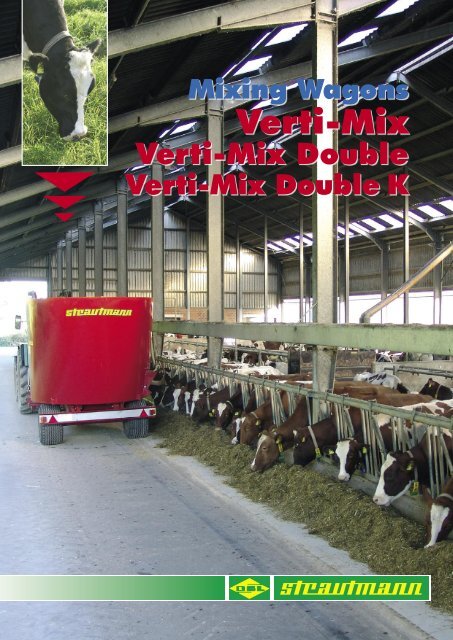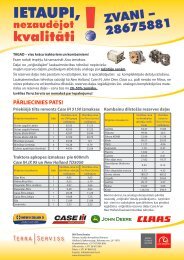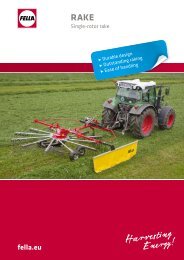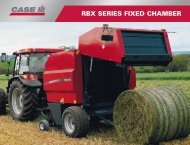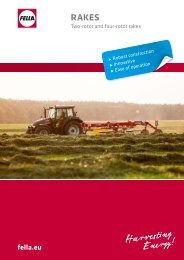Create successful ePaper yourself
Turn your PDF publications into a flip-book with our unique Google optimized e-Paper software.
3Table of contentsThe right mixer for everyone!Arguments that convince<strong>Verti</strong>-<strong>Mix</strong> stand for vertical mixers fromStrautmann. These are in use on cattle farmsall over the world. What the strenghts of themachines are can be read on Page 4-7<strong>Verti</strong>-<strong>Mix</strong> 400 / 500 -the entry level model Page 8/9- 1 vertical auger- 4 - 5 m³- Feeding of 10 - 35 cows per load- Power requirement starting from 35 HP on (26 kW)- Width between 1,79 - 1,88 m- Hight starting from 1,91 m<strong>Verti</strong>-<strong>Mix</strong> - the classic Page 10/11- 1 vertical vario mixing auger- 7,5 - 14,5 m³- Feeding of 30 - 120 cows per load- Power requirement starting from 28 - 50 HP (21 - 68 kW)- Width starting from 2,16 - 2,42 m- Hight starting from 2,38 - 3,23 m<strong>Verti</strong>-<strong>Mix</strong> Double- the big one Page 12/13- 2 vertical vario mixing augers- 12 - 28 m³- Feeding of 50 - 180 cows per load- Power requirement starting from 50 - 135 HP (37 - 100 kW)- Width starting from 2,16 - 2,42 m- Height starting from 2,26 - 3,32 m<strong>Verti</strong>-<strong>Mix</strong> Double K-the easy to pull all-rounder Page 14/15- 2 vertical vario mixing augers- 13 - 21 m³- Feeding of 50 - 150 cows per load- Power requirement starting from 55 - 74 HP (41 - 54 kW)- Width starting from 2,16 - 2,42 m- Height starting from 2,36 - 2,86 m
4Argumentsthat persuadeGearboxThe drive of the mixing auger consists of a veryrobust angular gear with planetary reduction.This leads to an optimised durability evenunder adverse conditions. The bearing ofthe auger consists of a solid body with aforged driveshaft and a big dimensionedtaper roller bearing taking in the leverageforce of the free standing auger.The durable oil and grease assures a verylow amount of maintenance and wear.„Vario“ mixing augerThe mixing auger and the container are perfectly matched to produce every fodder mix fast, preciselyand with low power requirement. The round form of the container supports a fast mixingand at the same time keeps the wear as low as possible. The heart of every foddermixing wagon is the mixing auger.The “vario” mixing auger developed by Strautmann has adjustable knifes andassures a fast and homogeneous mixing of all fodder components. Becausethe knives are positioned in inwards direction, the power requirementdecreases and a fuel saving of up to 25% can be realized. An additionalscraper at the bottom of the mixing auger assures a fast andeven unloading of the mixed fodder. Different types of cuttingknifes for a variety of operational conditions are available asoption.Counter cuttersThe mixing wagons are equippedwith two manual counterknives that simplify the cuttingof round and cubic bales. Asan option the counter knivescan also be operated hydraulicallyfrom the driver seat.Mineral feed funnelIf required a mineral feedfunnel can be mounted to thecontainer. This makes it easierto fill of smaller quantities ofconcerntrates like minerals orlime.Overflow ringFor the handling of round andsquare bales an overflow ringis recommended. The ringavoids fodder being pushedout of the container whilebales are chopped.Optionally a internal (no increaseof the height of thewagon) or a external ring(height of the wagon increasesby 150 mm) can be mounted.Extensions for the containerwith a height of 150 mm arealso available.
5Straw blowerAll types of <strong>Verti</strong>-<strong>Mix</strong> (except VM 400 / 500)can be optionally equipped with a strawblower. Ther vertical mixing system cutsand chops the straw bale. The blower unitis driven by a hydraulic motor and blowsthe straw up to 18 m into the barn. The endspout and the swivelling chute can be adjustedmanually. As option, they can be adjustedelectrically (end spout) and hydraulically(swivelling chute). For <strong>Verti</strong>-<strong>Mix</strong> and <strong>Verti</strong>-<strong>Mix</strong>double, the straw blowers can be fitted inthe front or back of the container. For the<strong>Verti</strong>-<strong>Mix</strong> K the straw blower can only beattached at the back of the container.OperationFor the operation of the individual functions direct hydraulic connection, cablecontrol and electro-hydraulic controls are available.Direct connectionThe direct connection requires one doubleacting control valve per function. It is especiallyuseful if the mixer wagon is connectedto the tractor most of the time or if the mixingwagon has just one door (just 1 double actingcontrol valve necessary).Cable controlThe operation with cable control requires onedouble acting control valve on the tractor –independent of the machine configuration.It is useful especially if older tractors withfew control valves are used with the mixingwagon. Also the two speed gearboxes areoperated with cable control as standard.Electro-hydraulic controlLike the cable control, the electro-hydrauliccontrol requires one double acting controlvalve independent of the machine configuration.Because of the compact size and lowweight it is favoured by customers who makeuse of the tractor also for other tasks thanpulling the mixing wagon.
6Discharge optionsthe right discharge for every farmCross conveyorBy means of a very wide PVC conveyor with adjustablespeed, the fodder can be discharged to the left or righton the feeding table. A unique lattice bar roller systemwith „V“ guide assures that no fodder comes between theroller barrel and conveyor belt. This ensures an extraordinarydurability of the Strautmann cross conveyor belts.Extension conveyors with a length of 1 m are alsoavailable.available for:VM 400/ VM VM VM500 Double D K– x x xSide dischargeFeeding out simultaneously on both sides is not possiblewith a cross conveyor. For this use Strautmann offers sidedischarges at different positions of the mixing wagon.These side discharges can be combined with elevators(length‘s 700 mm, 880 mm or 1240 mm).x x x xDischarge behind the wheelsUnder very narrow conditions 2 discharges at the backof the mixing wagon are recommended. The fodder isdistributed directly behind the wheels of the wagon.With this option, the mixing wagon can feed out evenif the fodder tables are not much wider than the wagonitself.– x x –Discharge at the backThe additional discharge at the back is proven for theproduction of pre-mixes. When the mixing of the pre-mix(usually dry material like minerals and concentrates,soya) is ready, it can be discharged behind the wagonwithout riding over it. The required amounts of the premixcan be easily applied to the individual fodder rations.– x x x
C-ConveyorDiscover the possibilities7C-conveyorThe unique c-conveyor is a cross conveyor that is build upon a flexible frame.Therefore it can be operated from the driver seat for different usage conditionswithout any modifications:Usage as cross conveyorFor ground-level feeding the conveyor can distribute fodderto the left or right. The optional electric conveyor speedcontrol is recommended enabling adjustment of speed to suitbarn conditions.Usage for horizontal movementThe c-conveyor can be moved horizontally 40 cm to the leftor right, this allows feeding into troughs which the wagoncannot drive close to. The compensator above the conveyorseals the conveyor to the opposite side of feeding makingsure no fodder falls out on to the floor.Usage as elevatorAs soon as the distance of 40 cm is reached horizontally,the c-conveyor moves upwards to a maximum of 60 cm(from its starting height) this make filling of high troughseasy. This system give the mixer wagon an additionalopportunty to distribute bedding material (consistent ofstraw, lime, water, sawdust etc.) into cubicle‘s.The c-conveyor will be available for chosen<strong>Verti</strong>-<strong>Mix</strong> models at the and of 2009.
8<strong>Verti</strong>-<strong>Mix</strong> 400 / 500small mixers - big effectThe model range <strong>Verti</strong>-<strong>Mix</strong> 400 / 500is the ideal start for farms into the livestockfriendlyTMR-feeding. At the constructionof this range, special attention was put atcompact sizes and cost-efficiency as well asreliability. Therefore it is the ideal start intoTMR feeding especially for smaller farmswith narrow ways.DrawbarThe fodder mixing wagons<strong>Verti</strong>-<strong>Mix</strong> 400 and 500 areavailable with top as well asbottom hitching. Both drawbarscan be adjusted to suit the respectiveoperational conditionswith the aid of hole frames. Asan option a bottom couplingwith hitch for the linkage drawbaris also available. In thiscase, the standard jack standis replaced by a simple supportstand with quick adjustment.AdditionFor the addition of small quantitiesof mineral or supplementaryingredients, the <strong>Verti</strong>-<strong>Mix</strong>400 and 500 are equippedwith a ladder at the back end.It can also be used to controlthe mixing process. Insteadof the ladder, a stairway isalso available. This additionalequipment allows it to bring inalso bigger amounts of foddercomponents manually.
9Fodder mixing wagon <strong>Verti</strong>-<strong>Mix</strong> 400 / <strong>Verti</strong>-<strong>Mix</strong> 500Type <strong>Verti</strong>-<strong>Mix</strong> 400 500Dimensions Length m 3,62 3,62Width with one-sided discharge m 1,79 1,79Width with double-sided discharge m 1,88 1,88Hight approx. m 1,91 2,17<strong>Mix</strong>ing capacity m³ 4,0 5,0max. total weight kg 3.000 3.000Own weight- with one-sided discharge kg 1.560 1.600- with double-sided discharge kg 1.660 1.700Track m 1,35 1,35Outside width of wheels m 1,62 1,62Feed-out height m 0,58 0,58Thickness of container walls mm 6 6Ground plate mm 12 12Dimensions with tyres 10.0/75-15.3 10.0/75-15.3Power requirements kW/HP 26/35 26/35All diagrams, technical data and weights are subject to change by way of ongoing technicaldevelopment of our products and are therefore not binding for delivery.Jack standAs a standard feature, the<strong>Verti</strong>-<strong>Mix</strong> 400 and 500 modelsare equipped with a mechanicaljack stand, which can bequickly adjusted, thus simplifyinghitching on and off. Asimple support is also availableas an option.ExtensionThe <strong>Verti</strong>-<strong>Mix</strong> 400 has a netmixing volume of 4 m³(VM 500: 5m³). On demand,both models can be equippedwith an extension, which canalso be bought as an upgrade.The height of the machineenlarges by 15 cm.
10<strong>Verti</strong>-<strong>Mix</strong>the classic for TMR feedingThe mixing wagons of the <strong>Verti</strong>-<strong>Mix</strong> range stand for optimal mixing quality with lowpower requirement and therefore can be found in cattle farms all over the world. Beside themilking machine, the mixing wagon is the only machine on a farm that has to work 365days per year. Therefore, the reliability of a mixing wagon is very important, and this is whatStrautmann mixers stand for.Wer als Anbieter von Futtermischwagenauf <strong>Verti</strong>kalmischer verzichtet, gibteinen Großteil des Marktes auf. Das hatStrautmann bereits vor fast zwölf Jahrenerkannt und brachte 1994 gleich fünf verschiedeneModelle mit Behältergrößenvon 8 bis 17 m³ auf den Markt. Die Behälterwurden bis 1998 teilweise noch vondem spanischen Mischwagenhersteller Tatomabezogen. Seitdem baut Strautmanndie Mischwagen komplett in eigener Regie.PROFI GEBRAUCHTDas Konzept hat von Anfang an gepasst.Aus heutiger Sicht jedoch nicht mehr akzeptabelwaren die anfangs eingebautenQuerträger über der Schnecke zur Stabilisierung.Wegen dieses Querträgers war esnämlich bei kleinen Mischern schwierig,Rundballensilage einzufüllen. Seit 1997konnte man auf diesen Querträger wahlweiseverzichten. Positiv war, dass es vonAnfang an ein Zweigangschaltgetriebegab. 1998 gab es das Schaltgetriebenur noch als Sonderausstattung.Gebrauchte <strong>Verti</strong>kalmischwagen von Strautmann:Von Anfang an gelungenSeit nunmehr zwölf Jahren baut Strautmann <strong>Verti</strong>kalmischwagenin allen gängigen Größen. 1999 gab es einen Modellwechsel, denSie beim Gebrauchtkauf berücksichtigen sollten. Technisch gibt eskeine Fallen. Selbst fünf Jahre alte <strong>Verti</strong>-<strong>Mix</strong>-Mischwagen warennach unserer Begutachtung noch gut in Schuss.Strautmann<strong>Verti</strong>-<strong>Mix</strong> 12501999 beendete Strautmann die Zusammenarbeitmit Tatoma und setzte voll aufEigenentwicklungen. Die Größen ändertensich, doch die wichtigste Änderungbetraf die Schnecke, die nach Angabenvon Strautmann nun weniger Kraft benötigte.Außerdem wurde ein zusätzlicherRäumer am Fuß der Schnecke angebracht,der für eine bessere Entleerung des Wagenssorgt (siehe Modellkalender). Wersich also für gebrauchte Wagen interessiert,sollte Modelle ab 1999 bevorzugen.Seitdem hat sich bei den Ein-Schnecken-Mischwagen nicht viel geändert. Allerdingsist die Ausstattung deutlich umfang-Spezielle Stroheinstreugeräte gibt eszwar schon länger. Aber wer den Futtermischwagenoder den einfacheren Futterverteilwagenzusätzlich zum Einstreuen derTretmist- oder Tiefstrohställe nutzen kann,spart Geld und das lästige Umhängenverschiedener Geräte. Natürlich muss dasGerät zum Betrieb, das heißt zu den Tierenund den Stallverhältnissen passen.Schon seit Jahren auf dem Markt, auch inDeutschland, sind die Futtermisch- und Verteilwagenvon Kuhn und Lucas.G. Vergleichsweiseneu sind dagegen Strohgebläseauf <strong>Verti</strong>kalmischwagen. Weil die <strong>Verti</strong>kalmischwagenheute den Markt beherrschen,sind Strohgebläse als Zusatzausstattungsicher für viele Betriebe interessant.Wie funktioniert die Technik? Um das herauszufinden,haben wir den Strautmann„<strong>Verti</strong>-<strong>Mix</strong>“ mit Strohgebläse im Einsatz beobachtet.Das Strohgebläse ist am Heck (aufWunsch auch an der Vorderseite) des Behältersangebaut. Der Behälter besitzt ei-PROFI TECHNIK-Stroh in Rund- und Quaderballen auflösen und verteilen:Mit dem FuttermischwageneinstreuenMit dem Gebläse amStrautmann-<strong>Verti</strong>-<strong>Mix</strong> wird das Strohbis zu 15 m weit in den Stall geblasen.profi 2/2006 0C www.profi.comprofi 2/2006 44 www.profi.comreicher geworden. Und es sind einige Modelledazugekommen. Aktuell sind der zeitbei den Ein-Schnecken-<strong>Verti</strong>kalmischerndie Größen 4 m³, 5 m³, 6 m³, 7,5 m³, 9 m³,10,5 m³, 12,5 m³ und 14,5 m³. Dass es keinenEin-Schnecken-<strong>Verti</strong>kalmischer mit17 m³ mehr gibt, liegt vor allem an demAngebot der <strong>Verti</strong>kalmischer mit zweiSchnecken (<strong>Verti</strong>-<strong>Mix</strong> Double), die Strautmannin den Größen von 12 bis 28 m³ imProgramm hat. Die Zwei-Schneckenmischersind bei gleichem Mischvolumendeutlich niedriger und schmaler als dieZwei Futtermischwagen im VergleichTiefstroh- oder Tretmistställe und auch Liegeboxen könnenmit der richtigen Technik mühelos eingestreut werden.Für <strong>Verti</strong>kalmischwagen werden Strohgebläse angeboten.Aber auch verschiedene Misch- und Verteilgeräte eignen sichneben der Futtervorlage zum Einstreuen.Strautmann<strong>Verti</strong>-<strong>Mix</strong> 1050nen zusätzlichen Schieber. Dahinter ist dasWurfrad des Gebläses angeflanscht. DasWurfrad hat ca. 1 m Durchmesser.Zunächst wird je nach Größe ein Rundballenbzw. ein Quaderballen Stroh in den Behältergegeben. Liegt der Strohballen im Behälter,kann es direkt zum Stall gehen. Esist nicht nötig, dass der Ballen zuvor minutenlangaufgelöst werden muss – zumindestnicht bei trocken gepresstem Stroh. DerBallen fällt quasi in Sekundenschnelle auseinander.Zwar ist jede Schnecke einesMischwagens mit Messern bestückt. Dochdie Schneidwirkung ist bei Standardmesserneher gering. Das Schneiden ist aberauch nicht das Ziel. Denn geschnitten werdenbraucht das Stroh nicht, weil es durchdas Gebläse mechanisch bearbeitet wird.Beim Einstreuen wird zunächst die Schneckein Gang gesetzt und dann das Gebläse.VON STEPHAN SCHMIDLINWer bei Strautmann einen12 m 3 grossen Futtermischwagenmit vertikalemMischsystem kaufen will, kann zwischenzwei verschiedenen Typenwählen. Der eine ist ein konventionellerEinschneckenmischer mit der Bezeichnung<strong>Verti</strong>-<strong>Mix</strong> 1250, der andereein Zweischneckenmischer mitder Bezeichnung <strong>Verti</strong>mix 1200Double.TECHNIKKurz und hoch gegenlang und niedrigStrautmann hat bei den 12 m 3 grossen<strong>Verti</strong>kalfuttermischwagen zwei Typenim Programm: einen Einschneckenmischerund einen Zweischneckenmischer.Wie sich die beiden Bauartenin ihrer Arbeitsweise unterscheiden, hatder «Landfreund» im Praxiseinsatz aufzwei Betrieben getestet.Das Gebläse wird hydraulisch von einer eigenenBordhydraulik angetrieben, zusätzlicheÖlanschlüsse am Schlepper sind nichterforderlich. So können mit dem Mischwagenauch weiterhin ältere Schlepper mit einergeringeren Ölförderleistung eingesetztwerden.Damit die vertikal stehendeSchnecke effizient arbeiten kann, isteine dem Volumen entsprechendeBauhöhe erforderlich. Anderseits erlaubtdie Durchfahrthöhe in vielenStällen den Einsatz eines hohen Futtermischwagensnicht. Damit dort dieVorteile des <strong>Verti</strong>kalmischers trotzdemgenutzt werden können, bietetStrautmann den <strong>Verti</strong>-<strong>Mix</strong> 1200Double an.Bei diesem Mischer sind zweiSchnecken hintereinander angeordnet,welche die Futtermenge je zurHälfte mischen. Die geringereBauhöhe, die so erreicht wird, hataber ihren Preis: Der <strong>Verti</strong>-<strong>Mix</strong> 1200Double ist der aufwändigeren Bauartentsprechend gut 8000 Franken teurerals sein Bruder mit gleichem Volumenund einer Mischschnecke.Das Gebläse eignet sich auch für Selbstfahr-<strong>Verti</strong>kalmischwagen mit zwei Schnecken.Die Mischungpasst genauBeim <strong>Verti</strong>-<strong>Mix</strong> 1250 kommt eineMischschnecke mit zweieinhalb Steigungenund neun Messern zum Einsatz.Die beiden Schnecken des <strong>Verti</strong>-<strong>Mix</strong> 1200 Double haben ebenfallszweieinhalb Steigungen und sindauch mit neun Messern bestückt. DieSchnecken sind aber deutlich kleiner.Die Messer können im Winkel verstelltwerden und arbeiten dann mehroder weniger aggressiv. Auch die Gegenschneidenbeeinflussen dieSchnittqualität. Unsere beiden Testwagenwaren mit mechanischen Gegenschneidenausgestattet.Sie erfüllen in der Regel ihrenZweck vollkommen. Der Montagegriffist aber zu klein, um die Gegenschneideherauszuziehen, wenn derBehälter zum Beispiel durch schwerauflösbare Rundballen verstopft ist.Wer oft langfaserige, trockene Silageballenaufzulösen hat, sollte sich fürBilder: zVg Im «Landfreund»-Praxistest wurde der<strong>Verti</strong>-<strong>Mix</strong> 1250 von Strautmann (oben)mit einem niedrig gebauten Zweischneckenmischergleichen Fassungsvermögens(rechts) verglichen.die auf Wunsch erhältliche hydraulischeVariante entscheiden.Das Mischen mehrerer Komponentenfunktionierte sehr gut. BeideTestfahrer, selber Besitzer andererMischwagen, waren überrascht, wieeffizient beide Wagen arbeiteten.Beim Zerkleinern des Inhalts warder Zweischneckenmischer im Vorsprung(siehe Kasten S. 25). Er zerkleinertedie langfaserigenFutterbestandteile in der gleichenMischzeit um bis zu 15 % besser alsder Einschneckenmischer.Was die Gleichmässigkeit der Mischungbetrifft, lag hingegen der Einschneckenmischervorn. So hatte erbei den Probeentnahmen an verschiedenenTagen eine leicht homogenereMischung vorzuweisen.Das Nutzvolumen gibt StrautmannStrautmann <strong>Verti</strong>-<strong>Mix</strong> –one says this about us: exklusive der Mischschnecken an.Trotzdem haben wir im Test festge-22LANDFREUND · 11/2005Im Zweischneckenmischer arbeitenzwei kleinere Mischschnecken, dieaber sonst von gleicher Bauart sind. stellt, dass der mit dem gleichen Volumengefüllte Zweischneckenmischereher zum Überlaufen neigt. Das lässtsich damit erklären, dass die beiden BrakesAll <strong>Verti</strong>-<strong>Mix</strong> are equipped witha standard hydraulic brake. Thiscan be activated directly fromthe tractor via the sing-leacting control valve. For higher speeds, i.e. on the roadat 25 km/h or 40 km/h, either the VM models 750 - 1050 canbe equipped with an over-running brake with automatic reverse system.All sizes can be equipped with a dual circuit compressed air brakesystem.
11Fodder mixing wagon <strong>Verti</strong>-<strong>Mix</strong>Type <strong>Verti</strong>-<strong>Mix</strong> 750 900 1050 1250 1450DimensionsLength with conveyor, front m 5,10 5,16 5,56 5,64 5,99Length with conveyor, rear m 4,62 4,62 4,90 4,98 –Length without conveyor m 4,41 4,47 4,75 4,84 –Width with conveyor m 2,16 2,16 2,28 2,42 2,42Width with one-sided discharge m 2,30 2,30 2,42 2,56 –Width with double-sided discharge m 2,44 2,44 2,56 2,70 –Hight approx. m 2,38 2,58 2,70 2,79 3,23Ap. height with external overflow ring m 2,53 2,73 2,85 2,94 3,38<strong>Mix</strong>ing capacity m³ 7,5 9,0 10,5 12,5 14,5max. total weight kg 6.000 6.740 8.000 9.000 10.000Own weight- with conveyor kg 3.260 3.300 3.860 4.150 4.900- with double-sided discharge kg 3.010 3.140 3.750 4.040 –Track m 1,50 1,50 1,60 1,60 1,70Outside width of wheels m 1,77 1,77 1,87 2,12 2,22Feed-out height m 0,74 0,74 0,73 0,71 0,71Thickness of container walls mm 8 8 8 8 8Ground plate mm 18 18 20 20 20Dimensions with tyres 10.0/75-15.3 (18 PR) 250-15 (18 PR) 8.15-15 (14 PR)Power requirementGearboxr/minwithout gearbox 20 kW/HP 27/37 28/38 - – –without gearbox 26 kW/HP 31/42 33/44 44/59 – –with gearbox 14/26 kW/HP 21/28 22/30 29/40 – –without gearbox 30 kW/HP 39/53 41/56 50/67 – –with gearbox 20/30 kW/HP 26/35 27/37 36/49 – –without gearbox 24 kW/HP – – – 50/67 –with gearbox 16/24 kW/HP – – – 33/45 –without gearbox 29 kW/HP – – – 60/81 –with gearbox 19/29 kW/HP – – – 43/58 –with gearbox 18/34 kW/HP – – – – 50/68All diagrams, technical data and weights are subject to change by way of ongoing technical development of our products and are therefore not binding for delivery.
12<strong>Verti</strong>-<strong>Mix</strong> Doublemaximum capacity for feedingThe particularly characteristic features of the fodder mixing trailer models <strong>Verti</strong>-<strong>Mix</strong> Doubleare the large mixing volume and the compact dimensions. Based on the verticalmixers well-known for their careful and fast mixing, the<strong>Verti</strong>-<strong>Mix</strong> Double has been equipped with 2 verticalaugers. Beside the fast mixing of highamounts of fodder, the <strong>Verti</strong>-<strong>Mix</strong> Doubletypes can play at their strengthswith the cutting and chopping ofround and cubic bales.GearboxTwo mixing augers equipped with sickle-shaped knives guaranteea fast and exact mixing of all fodder components.Even round or square bales are chopped and mixed in by theknives in no time. An additional clearing device fixed oppositethe auger entry ensures a consistent metering. A combinedcontrol and transfer gearbox with 2 speeds assures the transmissionover 2 pto shafts to the augers. Therefore, the gearboxesare used equally.Tandem axleFor longer road travelling or for higher speeds,a sprung tandem axle (standard on <strong>Verti</strong>-<strong>Mix</strong>Double 2400 to 2800) is recommended insteadof the standard individual axle. Differenttandem axles are available starting for the<strong>Verti</strong>-<strong>Mix</strong> 1400 Double. Starting with the<strong>Verti</strong>-<strong>Mix</strong> 2000 Double tandem steering axlesare available, which is advantageous for narrowconditions and reduces the wear at thetyres and chassis.<strong>Verti</strong>-<strong>Mix</strong> 1200 DoubleThe <strong>Verti</strong>-<strong>Mix</strong> 1200 Double has with 1.96 ma unique width for a fodder mixing wagonwhich makes it usable even under the narrowestconditions. To optimize the manoeuvrabilityin very narrow barns, it is available withan axle positioned in the middle. This reducesnot only the turn radius, but also reduces theheight of the machine.
13Fodder mixing wagon <strong>Verti</strong>-<strong>Mix</strong> DoubleTyp <strong>Verti</strong>-<strong>Mix</strong> 1200 1400 1700 2000 2400 N 2800DimensionsLength with conveyor, front m 6,99 7,40 7,46 7,78 8,07 8,22Length with conveyor, rear m 6,37 6,92 6,92 7,19 7,45 7,51Length without conveyor m 6,14 6,72 6,77 7,07 7,36 7,51Width with conveyor m 1,96 2,16 2,16 2,28 2,42 2,42Width with one-sided discharge m 2,10 2,30 2,30 2,42 2,56 2,56Width with double-sided discharge m 2,24 2,44 2,44 2,56 2,70 2,70Hight approx. m 2,42 2,38 2,58 2,71 3,09 3,34- with axle position middle m 2,37 – – 2,88 – –- with external overflow ring m 2,57 2,53 2,73 2,86 3,24 3,49<strong>Mix</strong>ing capacity m³ 12,0 14,0 17,0 20,0 24,0 28,0max. total weight- with single axle kg 10.500 11.800 11.800 11.800 – –- with tandem axle kg – 12.880 12.880 17.550 17.800 18.000Own weight with conveyor approx.- with single axle kg 4.930 6.250 6.420 7.145 – –- with tandem axle kg – 6.430 6.550 7.325 8.500 8.900Track- with single axle kg 1,50 1,50 1,50 1,50 – –- with tandem axle kg – 1,65 1,65 1,70 1,93 1,93Outside width of wheels- with single axle kg 1,91 2,02 2,02 2,02 – –- with tandem axle kg – 1,93 1,93 2,13 2,37 2,37Feedout height m 0,84 0,75 0,75 0,88 1,03 1,03Thickness of container walls mm 8 8 8 8 8 8Ground plate mm 18 20 20 20 20 20Dimensions with tyres- with single axle kg 400/60-15.5 8.15-15 (14 PR) 8.15-15 – –(18 PR) (14 PR)- with tandem axle kg – 10.0/75-15.3 400/60-15.5 435/50(18 PR) (18 PR) R 19.5Power requirementGearboxr/minwith gearbox 13/24 kW/HP – – – – 70/95 –without gearbox 26 kW/HP 54/73 – – – – –with gearbox 14/26 kW/HP – 53/72 60/81 66/90 – –with gearbox 17/26 kW/HP 37/50 – – – - –with gearbox 16/29 kW/HP – – – – 88/120 –without gearbox 30 kW/HP 65/88 – – – – –with gearbox 17/30 kW/HP – 66/90 74/100 82/110 – –with gearbox 20/30 kW/HP 47/63 – – – – –with gearbox 19/34 kW/HP – – – – – 100/135All diagrams, technical data and weights are subject to change by way of ongoing technical development of our products and are therefore not binding for delivery.
14<strong>Verti</strong>-<strong>Mix</strong> Double Kthe easy to pull all-rounderPreserving of feed structure, fast mixing, low wear, low maintenance costs anda low power requirement are the advantages of 2-auger vertical mixers in general. Butthey all have the disadvantage, that they cannot be fitted with large-volume tyres withoutincreasing the machine height exorbitantly.The <strong>Verti</strong>-<strong>Mix</strong> Double K is the only mixer on the market which combines theadvantages of the classical vertical mixers (preserving the feed structure,fast mixing, low wear, low maintenance, low power requirement) withthe advantages of the horizontal mixers (narrow design, highdimensionedtyres) because of its special mixer design.Special mixer designThe <strong>Verti</strong>-<strong>Mix</strong> Double K-types are equipped with differentmixing augers; the front auger has a biggerdiameter than the one in the rear. Also the bottomplate is adapted to this design; therefore the mixingcontainer is conical in the rear part.Through this arise a row of advantages for the everydaymixing application:- The starting torque is reduced up to 15%- Maintenance-free discharge via side doors- Optimum drawbar weight because of the specialmixer design.Special mixer design -big tyresThe special mixer design makes a fixingof 22,5“-tyres possible without any disadvantagein the measurements.This leads to the following advantages:- Very good mobility in connexion withexcellent running characteristics becauseof single axle with 22,5“ tyres- Low chassis maintenance compared withtandem axle solutions- Narrow and low machine because thetyres are fixed beside the mixer and donot overlap above the mixer
15Fodder mixing wagon <strong>Verti</strong>-<strong>Mix</strong> Double KType <strong>Verti</strong>-<strong>Mix</strong> 1300 Double K 1500 Double K 1800 Double K 2100 Double KDimensionsLength with conveyor, rear m 5,97 5,97 6,41 6,41Length without conveyor m 5,80 5,87 6,28 6,36Width with conveyor rear m 2,16 2,16 2,42 2,42Width with 1 discharge front right m 2,26 2,26 2,52 2,52Width with 1 discharge front left m 2,28 2,28 2,54 2,54Width with 2 discharges front m 2,38 2,38 2,64 2,64Height approx. m 2,36 2,58 2,61 2,86Height with external overflow ring ap. m 2,51 2,73 2,76 3,01<strong>Mix</strong>ing capacity m³ 13,0 15,0 18,0 21,0Max. total weight kg 11.800 11.800 12.000 12.000Approx. own weight kg 4.860 5.330 6.150 6.610Track m 1,85 1,85 2,06 2,06Outside width of wheels m 2,17 2,17 2,45 2,45Feedout height m 0,57 0,57 0,57 0,57Thickness of container walls mm 0,57 0,57 0,57 0,57Ground plate mm 20 20 20 20Dimensions with tyres 315/80 R 22.5 385/65 R 22.5Power requirementGearboxr/minwithout gearbox 20 kW/HP 46/63 50/68 – –without gearbox 24 kW/HP 53/72 57/78 64/88 71/96with gearbox 16/24 kW/HP 41/55 44/60 – –with gearbox 13/24 kW/HP – – 50/67 54/74without gearbox 29 kW/HP 60/81 65/88 73/99 80/109with gearbox 19/29 kW/HP 46/63 50/68 – –with gearbox 16/29 kW/HP – – 56/76 62/84All diagrams, technical data and weights are subject to change by way of ongoing technical development of our products and are therefore not binding for delivery.
The weighing device is an important component of thefodder mixing trailer. TheMeteringprofitability of the foddermixing trailer can only beandmade full use of by an exactmetering of the individual fodder components.For this purpose various systems are availablefor all requirements:weighingDigi-Star EZ 2400 V• adding weighing device• partial zero setting• mixing timer installed• 6 digits, each 43 mm highDigi-Star EZ 3400 V• programmable weighing devicewithout data-transfer• 200 ingredient memory locations• 6 digits each 43 mm high• identification of the componentsas running text• buzzer installed• [First Igredient Resize] - functionDigi-Star EZ 3600 V• programmable weighingdevice with data-transfervia data-key• 6 digits each 43 mm high• identification of the componentsas running textDigi-Star CC 400• additional display onlytogether with• EZ 2400 V to EZ 3200 V(wireless)• 6 digits, each 25 mm high• identification of the componentsas running text• range to 300 m2000/ivd/1109B. Strautmann & Söhne GmbH u. Co. KG · Bielefelder Straße 53 · D-49196 Bad LaerTel. +49(0 )54 24/8 02-0 · Fax +49(0 )54 24/8 02 76kontakt@strautmann.com · www.strautmann.com


